2020-11-05 - Nº 288
Editorial
Esta é a Newsletter Nº 288 que se apresenta com o mesmo formato que as anteriores. Se gostar da Newsletter partilhe-a!
Todas as Newsletters encontram-se indexadas no link.
Esta Newsletter tem os seguintes tópicos:
Faz hoje anos que nascia, em 1854, químico orgânico francês Paul Sabatier. Ele partilhou o Prémio Nobel de Química em 1912 com Victor Grignard.Sabatier pelas suas pesquisas em síntese orgânica catalítica, e descobertas do uso de níquel finamente dividido como catalisador na hidrogenação (a adição de hidrogénio a moléculas de compostos de carbono). As indústrias de margarina, hidrogenação a óleo e metanol sintético cresceram a partir deste trabalho. Ele descobriu que aumentar a área de superfície de catalisadores como cobre e níquel dividindo-os de forma muito fina aumenta muito sua eficácia. Sabatier fez uma ampla pesquisa sobre o uso de catalisadores em sintetizadores de química orgânica, revelando que metais que não sejam níquel, embora menos eficazes, também podem se comportar como catalisadores.
Faz também hoje anos que nascia, em 1893, o inventor e engenheiro americano Raymond Loewy. Nascido na França, ele ficou conhecido como o "Pai da Simplificação". Exemplos famosos dos seus projectos incluem o Studebaker1947 Starlight Coupe, o Starliner Coupe de 1953 e o Avanti 1961 - desenhos que geraram um interesse público e aceitação muito fora de proporção ao tamanho relativo da empresa na indústria; a linha de 1947 dos receptores de rádio Hallicrafter que transmitiam uma precisão nítida muito à frente de seu tempo; a máquina de duplicação Gestetner de 1929, a Geladeira Sears Coldspot de 1934 e a locomotiva a vapor S-1 para a Estrada de Ferro da Pensilvânia - todos os projectos de referência influentes no estabelecimento de padrões de design mais elevados nas suas respectivas áreas de design. Ele também projectou itens menores como escovas de dentes, lâminas de barbear, móveis e a Garrafa de Coca-Cola.
Faz igualmente hoje anos que nascia, em 1927, o estatístico japonês Hirotugu Akaike. Ele formulou o critério de informação de Akaike (AIC). A AIC é hoje amplamente utilizada para a selecção de modelos, que é comummente o aspecto mais difícil da inferência estatística; além disso, a AIC é a base de um paradigma para os fundamentos das estatísticas. Akaike também fez grandes contribuições para o estudo de séries temporais. Além disso, ele teve um grande papel no desenvolvimento geral das estatísticas no Japão.
Por fim, faz hoje anos que nascia, em 1948, o físico norte-americano William D. Phillips. As suas experiências com luz laser para arrefecer e prender átomos fez que com que fosse atribuída uma parte do Prémio Nobel de Física em 1997 (com Steven Chu e Claude Cohen-Tannoudji). Eles desenvolveram métodos para usar luz laser para arrefecer gases à faixa de temperatura microkelvin perto do zero absoluto, e mantendo os átomos refrigerados flutuando ou capturados em diferentes tipos de "armadilhas atómicas". A luz laser funciona como um líquido espesso, apelidado de melaço óptico, no qual os átomos são desacelerados. Átomos individuais podem ser assim estudados com uma precisão muito grande e a sua estrutura interna pode ser determinada. À medida que mais e mais átomos são capturados no mesmo volume, forma-se um gás fino, e as suas propriedades podem ser estudadas em detalhes.
Faz hoje 13 anos que era criado o sistema Android. A Google, depois de alguma especulação, e após ter comprado uma pequena startup chamada "Android", entra no mercado dos smartphones. Depois de rumores indicando o contrário a Google anunciou que o Android seria uma plataforma aberta para todos através da "Open Handset Alliance". A Google prometeu que o Android mudaria o status quo, e definitivamente cumpriu, tendo actualmente mais de 72% do mercado mundial de smartphones, de acordo com algumas estimativas recentes (se não mais).
E nesta semana que passou a fundação Raspberry Pi fez mais um anuncio estrondoso. Um teclado com um Raspberry Pi no seu interior por 70 USD. Inspirado nos computadores domésticos da década de 1980, a missão da fundação Raspberry Pi é colocar computadores programáveis de alto desempenho e acessíveis nas mãos de pessoas em todo o mundo. E inspirado por esses PCs clássicos, aqui está o Raspberry Pi 400: um computador pessoal completo, integrado num teclado compacto. Usando o mesmo footprint dos teclados anteriormente lançados, foi desenhada uma placa Raspberry Pi que se ajustasse perfeitamente a ser colocada dentro deste teclado. O resultado é um Raspberry PI 4 em formato de "teclado" com uma velocidade de relógio de processador de 1.8Ghz, com arrefecimento passivo e 4GB de memória. Tem 3 Portas USB (2 USB3), a porta Gigabit Ethernet, duas portas micro-HDMI, uma slot para o microSD e os 40 pinos. Usa um interface USB-C para ser ligado à corrente.
Na Newsletter desta semana apresentamos diversas noticias, artigos científicos assim como projetos de maker. É apresentado o livro "Raspberry Pi Beginner's Guide 4th Edition" que entre outras coisas aborda o novo Raspberry Pi 400.
 João Alves ([email protected])
João Alves ([email protected])
O conteúdo da Newsletter encontra-se sob a licença  Creative Commons Attribution-NonCommercial-ShareAlike 4.0 International License.
Creative Commons Attribution-NonCommercial-ShareAlike 4.0 International License.
Novidades da Semana

Raspberry Pi 400: the $70 desktop PC
"Raspberry Pi has always been a PC company. Inspired by the home computers of the 1980s, our mission is to put affordable, high-performance, programmable computers into the hands of people all over the world. And inspired by these classic PCs, here is Raspberry Pi 400: a complete personal computer, built into a compact keyboard. Raspberry Pi 4, which we launched in June last year, is roughly forty times as powerful as the original Raspberry Pi, and offers an experience that is indistinguishable from a legacy PC for the majority of users. Particularly since the start of the COVID-19 pandemic, we’ve seen a rapid increase in the use of Raspberry Pi 4 for home working and studying. But user friendliness is about more than performance: it can also be about form factor." [...]
Outras Notícias

Innovation Extends with Intel Iris Xe MAX Graphics and Deep Link
"Today, Intel launched Intel® Iris® Xe MAX graphics, designed for thin-and-light laptops and now available from partners. Intel Iris Xe MAX graphics is based on the same Xe-LP microarchitecture used for Intel Iris Xe graphics in 11th Gen Intel® Core™ mobile processors. It is Intel’s first Xe-based discrete graphics processing unit (GPU) as part of the company’s strategy to enter the discrete graphics market. Intel Iris Xe MAX platforms feature Intel® Deep Link technology as part of Intel® Adaptix™, support PCIe Gen 4 and address an emerging need for content creation performance in thin-and-light laptops. During Intel® Architecture Day, Intel announced that the Xe-LP microarchitecture will deliver advanced performance for mobile platforms. Intel Iris Xe graphics has been a game changer for the mobile PC visual experience and, together with 11th Gen Intel Core mobile processors, delivers amazing low-power graphics with leading media, display and AI." [...]

Samsung and KT Complete Korea’s First 5G SA and NSA Common Core Network Deployment
"The companies deployed a 5G common core network that can operate in both 5G Standalone (SA) and Non-Standalone (NSA) modes simultaneously Samsung Electronics and KT Corporation (KT) announced they have successfully deployed Korea’s first 5G Standalone (SA) and Non-Standalone (NSA) common core in KT’s commercial network. KT will commercially launch its SA network when 5G SA-capable devices become available in the market. Samsung’s common core will run in KT’s Mobile Edge Computing (MEC) telecom centers across eight major Korean cities, building on a collaboration towards the full commercialization of 5G SA networks in Korea. Samsung and KT have been collaborating since the development stage to deliver key 5G SA technologies on KT’s NSA infrastructure, which incorporates Samsung’s Control and User Plane Separation (CUPS) solution, edge traffic steering, and network slicing capabilities. KT launched 5G commercial services in NSA mode last April, making them the only operator in Korea to adopt CUPS solution in its network. The CUPS architecture, defined in 3GPP standards, is a fundamental technology to 5G SA core that improves network scalability, flexibility and deployment by separating the control and user plane functions." [...]

Microchip’s High-Performance FPGA is First of its Kind to Achieve QML Class V in Ceramic Quad Flat Package
"RTG4™ FPGAs offer a unique combination of radiation hardening by design, qualification to QML Class V and packaging that simplifies board design, inspection and assembly Microchip Technology (Nasdaq: MCHP) today announced its RTG4™ Field Programmable Gate Array (FPGA) family is the first in a Ceramic Quad Flat Pack (CQFP) option to achieve qualification to the industry’s Qualified Manufacturers List (QML). The achievement will enable space system developers to create systems using more reliable packages that simplify the layout and routing of Printed Circuit Boards (PCBs) that are also easier to assemble and inspect. “We have culminated years of testing, verification and flight heritage to offer a CQFP FPGA at the RTG4 FPGA density and performance level that is qualified to QML Class V, the highest reliability standard for spaceflight systems,” said Shakeel Peera, associate vice president of marketing for Microchip’s FPGA business unit. “Our high-speed radiation-tolerant RTG4 FPGAs were the first of their kind to achieve QML Class V qualification in any package type. They also were the first in their class to be offered in the 352-pin CQFP that is one of the most popular package types for space flight systems.” Microchip’s CQFP package with 352 pins for RTG4 FPGAs simplifies system design in applications ranging from satellites and space probes to planet landers and vehicles. The CQFP package option is easier to assemble than Ceramic Column Grid Array packages, further improving reliability while enabling a more cost-effective system integration alternative to higher-pin-count alternatives." [...]
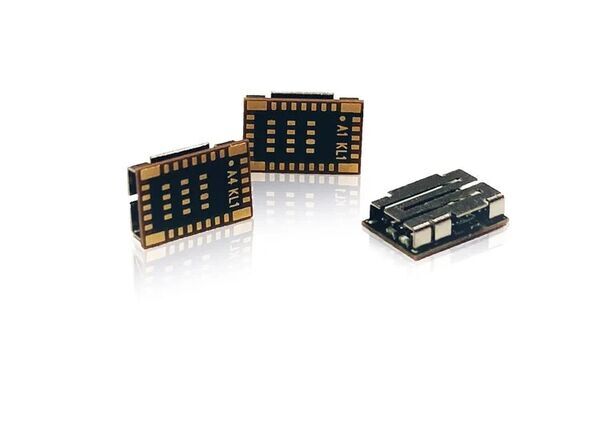
Miniaturized Bluetooth LE modules support wide range of space-constrained IoT applications
"LG Innotek’s ETWBCLU03 and ETWBCLU01 modules employ Nordic’s nRF52833 and nRF52810 SoCs to deliver extended temperature range multiprotocol connectivity for compact devices Nordic Semiconductor today announces that Seoul, Korea-based electronics components giant, LG Innotek, has selected Nordic’s nRF52833 Bluetooth® Low Energy (Bluetooth LE) advanced multiprotocol System-on-Chip (SoC) and nRF52810 Bluetooth LE SoC to provide the core processing power and wireless connectivity for its ‘ETWBCLU03’ and ‘ETWBCLU01’ modules. Tiny form factor The ETWBCLU03 module with integrated antenna comes in a miniaturized 7 by 5 by 1.6mm form factor and is qualified over an extended –40º to 105º C operating temperature range. The nRF52833 SoC’s extended temperature range, large memory capacity (512kB Flash and 128kB RAM), as well as dynamic multiprotocol support enabling concurrent wireless protocol connectivity, ensures the ETWBCLU03 module is suitable for a wide range of IoT applications including those subject to elevated temperatures, for example enterprise lighting or industrial applications. In addition, the nRF52833 offers Full Speed USB operation allowing the module to be used for USB-compatible wired peripheral applications. USB is a popular connectivity interface that enables low-latency and high-bandwidth communication with a range of host devices, such as PCs, smartphones, and gateways. The connectivity also makes device firmware updates (DFU)-over-USB practical." [...]

Marvell to Acquire Inphi - Accelerating Growth and Leadership in Cloud and 5G Infrastructure
"Marvell Technology Group Ltd. (NASDAQ: MRVL), a leader in infrastructure semiconductor solutions, and Inphi Corporation (NASDAQ: IPHI), a leader in high-speed data movement, today announced a definitive agreement, unanimously approved by the boards of directors of both companies, under which Marvell will acquire Inphi in a cash and stock transaction. In conjunction with the transaction, Marvell intends to reorganize so that the combined company will be domiciled in the United States, creating a U.S. semiconductor powerhouse with an enterprise value of approximately $40 billion. Inphi has built a leading high-speed data interconnect platform uniquely suited to meet the insatiable demand for increased bandwidth and low power for the cloud data centers and global networks of the future. Inphi’s high-speed electro-optics portfolio provides the connectivity fabric for cloud data centers and wired and wireless carrier networks, just as Marvell’s copper physical layer portfolio does for enterprise and future in-vehicle networks. Combining Marvell’s storage, networking, processor, and security portfolio, with Inphi’s leading electro-optics interconnect platform, will position the combined company for end-to-end technology leadership in data infrastructure. This highly complementary transaction expands Marvell’s addressable market, strengthens customer base, and accelerates Marvell’s leadership in hyperscale cloud data centers and 5G wireless infrastructure." [...]

SpaceX launches next-gen GPS satellite for US Space Force, lands rocket
"SpaceX successfully launched an advanced GPS satellite for the U.S. Space Force on Thursday (Nov. 5), marking the first launch in nearly two weeks here on the Space Coast. One of the company's two-stage Falcon 9 rockets blasted off from Space Launch Complex 40 at Cape Canaveral Air Force Station here at 6:24 p.m. EST (2324 GMT), carrying the GPS III-SV04 satellite to orbit. Nine minutes later, the rocket's first stage touched down on the deck of "Of Course I Still Love You," one of SpaceX's two drone ships. The GPS III-SV04 mission had been set to follow on the heels of a United Launch Alliance (ULA) Atlas V rocket, which was scheduled to loft a U.S. spy satellite from Cape Canaveral on Tuesday (Nov. 3). However, the Atlas V launch was delayed twice due to issues with ground systems equipment. ULA is now targeting Friday (Nov. 6) for that liftoff." [...]

NASA Contacts Voyager 2 Using Upgraded Deep Space Network Dish
"The only radio antenna that can command the 43-year-old spacecraft has been offline since March as it gets new hardware, but work is on track to wrap up in February. On Oct. 29, mission operators sent a series of commands to NASA's Voyager 2 spacecraft for the first time since mid-March. The spacecraft has been flying solo while the 70-meter-wide (230-foot-wide) radio antenna used to talk to it has been offline for repairs and upgrades. Voyager 2 returned a signal confirming it had received the "call" and executed the commands without issue. The call to Voyager 2 was a test of new hardware recently installed on Deep Space Station 43, the only dish in the world that can send commands to Voyager 2. Located in Canberra, Australia, it is part of NASA's Deep Space Network (DSN), a collection of radio antennas around the world used primarily to communicate with spacecraft operating beyond the Moon." [...]
Ciência e Tecnologia
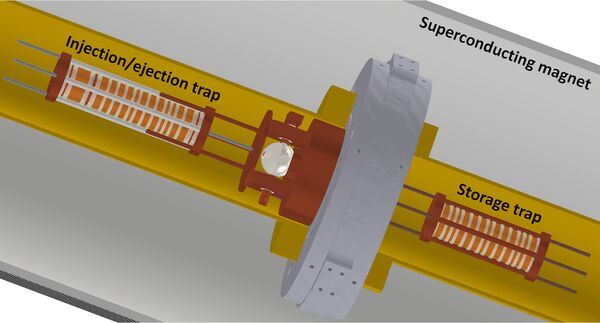
A transportable antiproton trap to unlock the secrets of antimatter
"The BASE collaboration is developing a transportable antiproton trap to make higher-precision measurements of the properties of antimatter The BASE collaboration at CERN has bagged more than one first in antimatter research. For example, it made the first ever more precise measurement for antimatter than for matter, it kept antimatter stored for a record time of more than a year, and it conducted the first laboratory-based search for an interaction between antimatter and a candidate particle for dark matter called the axion. Now, the BASE team is developing a device that could take antimatter research to new heights – a transportable antiproton trap to carry antimatter produced at CERN’s Antimatter Decelerator (AD) to another facility at CERN or elsewhere, for higher-precision antimatter measurements. These measurements could uncover differences between matter and antimatter. The Big Bang should have created equal amounts of matter and antimatter, yet the present-day universe is made almost entirely of matter, so something must have happened to create the imbalance. The Standard Model of particle physics predicts a certain difference between matter and antimatter, but this difference is insufficient to explain the imbalance, prompting researchers to look for other, as-yet-unseen differences between the two forms of matter." [...]

A New Approach for Studying Electric Charge Arrangements in a Superconductor
"X-ray scattering yields new information on "charge density waves" High-temperature superconductors are a class of materials that can conduct electricity with almost zero resistance at temperatures that are relatively high compared to their standard counterparts, which must be chilled to nearly absolute zero—the coldest temperature possible. The high-temperature materials are exciting because they hold the possibility of revolutionizing modern life, such as by facilitating ultra-efficient energy transmission or being used to create cutting-edge quantum computers. One particular group of high-temperature superconductors, the cuprates, has been studied for 30 years, yet scientists still cannot fully explain how they work: What goes on inside a “typical” cuprate? Piecing together a complete picture of their electronic behavior is vital to engineering the “holy grail” of cuprates: a versatile, robust material that can superconduct at room temperature and ambient pressure. To that end, a research group led by scientists from the U.S. Department of Energy’s (DOE’s) Brookhaven National Laboratory recently discovered new information about the electronic behavior of a particular cuprate using an x-ray technique that has not—until now—been widely used to study them. Working in part at Brookhaven Lab’s National Synchrotron Light Source II (NSLS-II), a DOE Office of Science User Facility, the researchers used a form of x-ray scattering to investigate a specific arrangement of electric charge that arises in cuprates: an ordered pattern of electrons known as a charge-density wave (CDW)." [...]
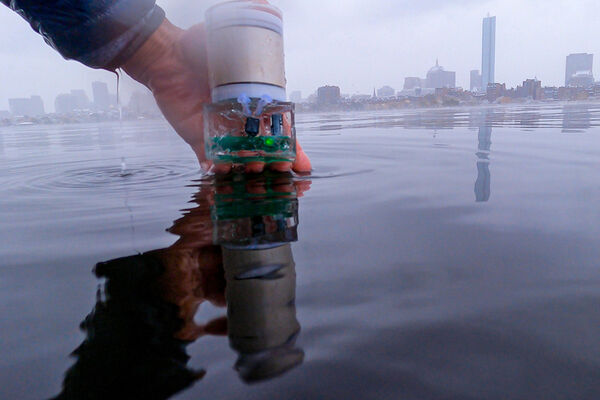
An underwater navigation system powered by sound
"New approach could spark an era of battery-free ocean exploration, with applications ranging from marine conservation to aquaculture. GPS isn’t waterproof. The navigation system depends on radio waves, which break down rapidly in liquids, including seawater. To track undersea objects like drones or whales, researchers rely on acoustic signaling. But devices that generate and send sound usually require batteries — bulky, short-lived batteries that need regular changing. Could we do without them?" [...]
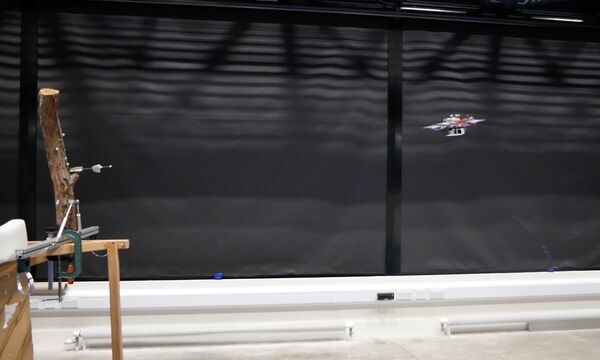
Dart-Shooting Drone Attacks Trees for Science
"We all know how robots are great at going to places where you can’t (or shouldn’t) send a human. We also know how robots are great at doing repetitive tasks. These characteristics have the potential to make robots ideal for setting up wireless sensor networks in hazardous environments—that is, they could deploy a whole bunch of self-contained sensor nodes that create a network that can monitor a very large area for a very long time. When it comes to using drones to set up sensor networks, you’ve generally got two options: A drone that just drops sensors on the ground (easy but inaccurate and limited locations), or using a drone with some sort of manipulator on it to stick sensors in specific places (complicated and risky). A third option, under development by researchers at Imperial College London’s Aerial Robotics Lab, provides the accuracy of direct contact with the safety and ease of use of passive dropping by instead using the drone as a launching platform for laser-aimed, sensor-equipped darts. These darts (which the researchers refer to as aerodynamically stabilized, spine-equipped sensor pods) can embed themselves in relatively soft targets from up to 4 meters away with an accuracy of about 10 centimeters after being fired from a spring-loaded launcher." [...]

Next-generation computer chip with two heads
"EPFL engineers have developed a computer chip that combines two functions – logic operations and data storage – into a single architecture, paving the way to more efficient devices. Their technology is particularly promising for applications relying on artificial intelligence. It’s a major breakthrough in the field of electronics. Engineers at EPFL’s Laboratory of Nanoscale Electronics and Structures (LANES) have developed a next-generation circuit that allows for smaller, faster and more energy-efficient devices – which would have major benefits for artificial-intelligence systems. Their revolutionary technology is the first to use a 2D material for what’s called a logic-in-memory architecture, or a single architecture that combines logic operations with a memory function. The research team’s findings appear today in Nature." [...]
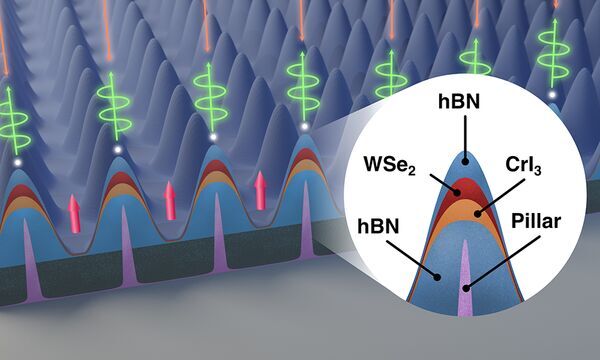
Building a quantum network one node at a time
"New research demonstrates a way to use quantum properties of light to transmit information, a key step on the path to the next generation of computing and communications systems. Researchers at the University of Rochester and Cornell University have taken an important step toward developing a communications network that exchanges information across long distances by using photons, mass-less measures of light that are key elements of quantum computing and quantum communications systems. The research team has designed a nanoscale node made out of magnetic and semiconducting materials that could interact with other nodes, using laser light to emit and accept photons. The development of such a quantum network—designed to take advantage of the physical properties of light and matter characterized by quantum mechanics—promises faster, more efficient ways to communicate, compute, and detect objects and materials as compared to networks currently used for computing and communications. Described in the journal Nature Communications, the node consists of an array of pillars a mere 120 nanometers high. The pillars are part of a platform containing atomically thin layers of semiconductor and magnetic materials." [...]
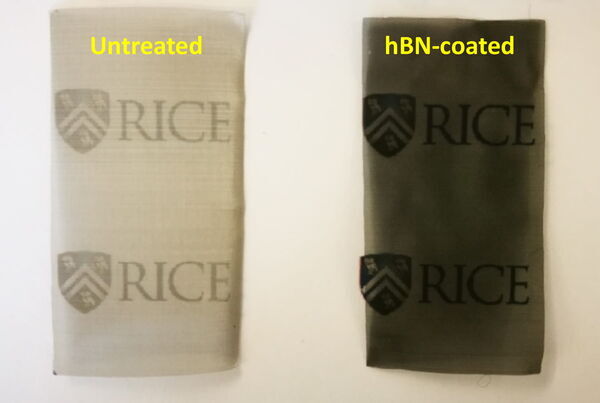
Industrial-strength brine, meet your kryptonite
"Boron nitride coating is key ingredient in hypersaline desalination technology A thin coating of the 2D nanomaterial hexagonal boron nitride is the key ingredient in a cost-effective technology developed by Rice University engineers for desalinating industrial-strength brine. More than 1.8 billion people live in countries where fresh water is scarce. In many arid regions, seawater or salty groundwater is plentiful but costly to desalinate. In addition, many industries pay high disposal costs for wastewater with high salt concentrations that cannot be treated using conventional technologies. Reverse osmosis, the most common desalination technology, requires greater and greater pressure as the salt content of water increases and cannot be used to treat water that is extremely salty, or hypersaline. Hypersaline water, which can contain 10 times more salt than seawater, is an increasingly important challenge for many industries." [...]
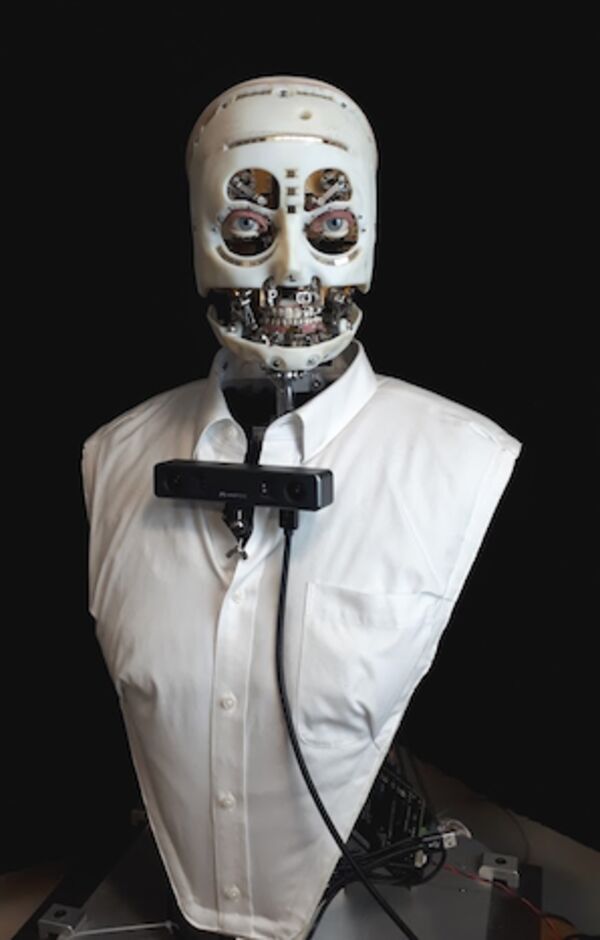
Realistic and Interactive Robot Gaze
"This paper describes the development of a system for lifelike gaze in human-robot interactions using a humanoid Audio-Animatronics® bust. Previous work examining mutual gaze between robots and humans has focused on technical implementation. We present a general architecture that seeks not only to create gaze interactions from a technological standpoint, but also through the lens of character animation where the fidelity and believability of motion is paramount; that is, we seek to create an interaction which demonstrates the illusion of life. A complete system is described that perceives persons in the environment, identifies persons-of-interest based on salient actions, selects an appropriate gaze behavior, and executes high, fidelity motions to respond to the stimuli. We use mechanisms that mimic motor and attention behaviors analogous to those observed in biological systems including attention habituation, saccades, and differences in motion bandwidth for actuators. Additionally, a subsumption architecture allows layering of simple motor movements to create increasingly complex behaviors which are able to interactively and realistically react to salient stimuli in the environment through subsuming lower levels of behavior." [...]

Astronomers report first detection of ultrabright radio flashes in our own galaxy
"The fast radio bursts are likely generated by a magnetar, the most magnetic type of star in the universe. Fast radio bursts are extremely bright flashes of energy that last for a fraction of a second, during which they can blast out more than 100 million times more power than the sun. Since they were first detected in 2007, astronomers have observed traces of fast radio bursts, or FRBs, scattered across the universe, but their sources have been too far away to clearly make out. It has been a mystery, then, as to what astrophysical objects could possibly produce such brief though brilliant radio flares. Now astronomers at MIT, McGill University, the University of British Columbia, the University of Toronto, the Perimeter Institute for Theoretical Physics, and elsewhere report that they have observed fast radio bursts in our own galaxy, for the first time. The radio pulses are the closest FRBs detected to date, and their proximity has allowed the team to pinpoint their source." [...]

Computational methods to ease the reuse of construction components
"Algorithms developed at EPFL can help architects to design building structures that incorporate both new and reused components, thereby lowering their environmental impact. The construction industry is among the world’s most polluting sectors: in developed countries it accounts for some 40% of CO2 emissions. It consumes up to half of all resources and generates about a third of all waste. As a result, in order to comply with international treaties and the United Nations' Sustainable Development Goals, the industry is being forced to take bold steps to reduce its environmental footprint. “We need to mitigate this impact as quickly as possible," says Jan Brütting, who has just completed a PhD at EPFL’s Structural Xploration Lab (SXL), headed by Corentin Fivet from the Smart Living Lab in Fribourg. “One way to achieve this is by systematically implementing the principles of the circular economy.” When designing a building, instead of using new components or even recycling existing metal parts by melting them down and casting them into new shapes, Brütting encourages companies, structural engineers and architects to base their designs on previously-used components, without reprocessing them." [...]
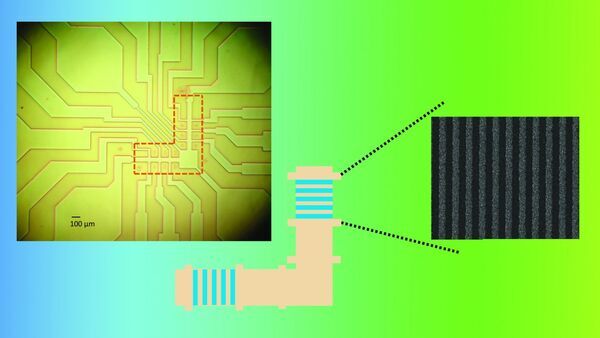
Strange quasi-particles reveal new magnetic behavior, verify nearly century-old prediction
"Princeton researchers have confirmed a theory first put forward in 1929 by the Nobel laureate Felix Bloch, who theorized that certain kinds of materials, when drawn down to a very low electron density, would spontaneously magnetize. In the study, published August 17 in Nature Physics, researchers led by Mansour Shayegan, professor of electrical engineering, used an ultra-pure semiconductor to explore what happens to electrons as they become less densely packed in a two-dimensional space, a plane between two solids that is only one particle deep. As the team slowly reduced the material's electron density, they first saw an expected result: its magnetic properties became weaker until they disappeared altogether. While very few systems have explored electron density at this level, the mathematics made sense of the results to that point. The researchers had surpassed a critical threshold. But because they were working with a rare material system that allowed them to study these effects at even lower densities, they decided to keep going and push the experiment to its physical brink." [...]

3D print experts discover how to make tomorrow’s tech using ink-jet printed graphene
"The University of Nottingham has cracked the conundrum of how to use inks to 3D-print novel electronic devices with useful properties, such as an ability to convert light into electricity. The study shows that it is possible to jet inks, containing tiny flakes of 2D materials such as graphene, to build up and mesh together the different layers of these complex, customised structures. Using quantum mechanical modelling, the researchers also pinpointed how electrons move through the 2D material layers, to completely understand how the ground-breaking devices can be modified in future. The study, ‘Inter‐Flake Quantum Transport of Electrons and Holes in Inkjet‐Printed Graphene Devices’, has been published in the peer-reviewed journal Advanced Functional Materials. Often described as a ‘super material’, graphene was first created in 2004. It exhibits many unique properties including being stronger than steel, highly flexible and the best conductor of electricity ever made." [...]

Higgs boson probes for new phenomena
"LHC physicists are on the hunt for many different forms of phenomena beyond the Standard Model. Some theories predict an as-yet undiscovered particle could be found in the form of a new resonance (a narrow peak) similar to the one that heralded the discovery of the Higgs boson in 2012. However, Nature is not always so kind and new resonances may be so massive that their production requires collision energies beyond that of the LHC. If so, all is not lost. Just as gently sloping terrain may indicate the presence of a mountain peak ahead, LHC data may contain some hints that interesting phenomena are present at higher energy scales. A very effective model Instead of looking for a new particle, physicists can look for new types of interactions, not present in the Standard Model." [...]

Self-Watering Soil Could Transform Farming
"A new type of soil created by engineers at The University of Texas at Austin can pull water from the air and distribute it to plants, potentially expanding the map of farmable land around the globe to previously inhospitable places and reducing water use in agriculture at a time of growing droughts. As published in ACS Materials Letters, the team’s atmospheric water irrigation system uses super-moisture-absorbent gels to capture water from the air. When the soil is heated to a certain temperature, the gels release the water, making it available to plants. When the soil distributes water, some of it goes back into the air, increasing humidity and making it easier to continue the harvesting cycle. “Enabling free-standing agriculture in areas where it’s hard to build up irrigation and power systems is crucial to liberating crop farming from the complex water supply chain as resources become increasingly scarce,” said Guihua Yu, associate professor of materials science in the Walker Department of Mechanical Engineering. Each gram of soil can extract approximately 3-4 grams of water." [...]
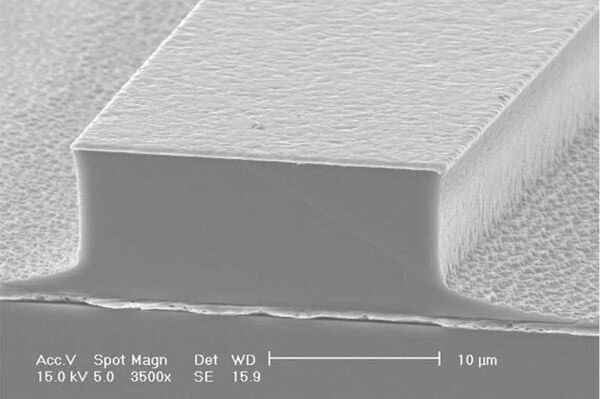
Researchers develop a high-power, portable terahertz laser
"The instrument could bring powerful sensing and imaging capabilities out of the lab and into hospitals, airports, or other settings. Researchers at MIT and the University of Waterloo have developed a high-power, portable version of a device called a quantum cascade laser, which can generate terahertz radiation outside of a laboratory setting. The laser could potentially be used in applications such as pinpointing skin cancer and detecting hidden explosives. Until now, generation of terahertz radiation powerful enough to perform real-time imaging and fast spectral measurements required temperatures far below 200 kelvins (-100 degrees Fahrenheit) or lower. These temperatures could only be achieved with bulky equipment that limited the technology’s use to a laboratory setting. In a paper published today in Nature Photonics, MIT Distinguished Professor of Electrical Engineering and Computer Sciences Qing Hu and his colleagues report that their terahertz quantum cascade laser can function at temperatures of up to 250 K (-10 F), meaning that only a compact portable cooler is required." [...]
Blue Phosphorus: How a Semiconductor Becomes a Metal
"Blue phosphorus, an atomically thin synthetic semiconductor, becomes metallic as soon as it is converted into a double layer. This has been discovered by an interdisciplinary team led by Prof Thomas Heine from TU Dresden and Prof Gabriel Merino from the Mexican research institute Cinvestav Merida. The scientists are first to describe the possibility of constructing nanoscale, highly efficient transistors consisting of only one element. The results of these investigations were published as highlight article in the current issue of the journal "Physical Review Letters". The chemical element phosphorus is considered one of the most essential elements for life. Phosphorus compounds are deeply involved in the structure and function of organisms." [...]
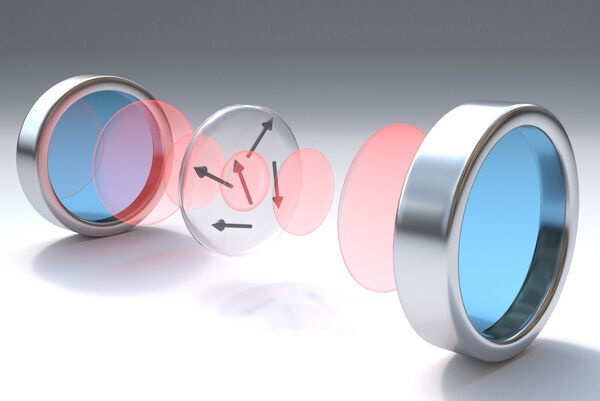
Physicists have developed an efficient modem for the future quantum internet
"Physicists at the Max Planck Institute of Quantum Optics have developed the basic technology for a new "quantum modem". It will allow users to connect to a future quantum internet that is based on the existing fibre optic network infrastructure. The first quantum revolution brought about semiconductor electronics, the laser and finally the internet. The coming, second quantum revolution promises spy-proof communication, extremely precise quantum sensors and quantum computers for previously unsolvable computing tasks. But this revolution is still in its infancy. A central research object is the interface between local quantum devices and light quanta that enable the remote transmission of highly sensitive quantum information." [...]
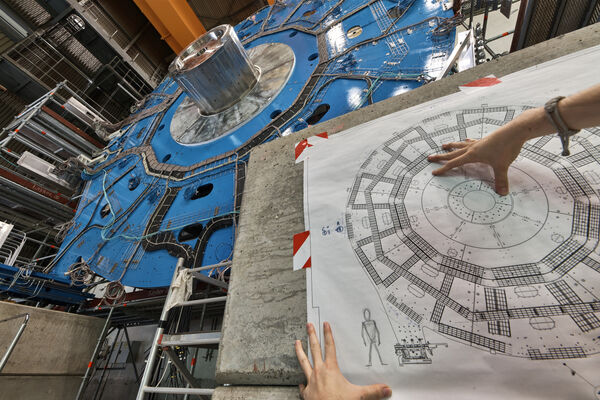
Know When to Unfold ’Em: Study Applies Error-Reducing Methods from Particle Physics to Quantum Computing
"‘Unfolding’ techniques used to improve the accuracy of particle detector data can also improve the readout of quantum states from a quantum computer Borrowing a page from high-energy physics and astronomy textbooks, a team of physicists and computer scientists at the U.S. Department of Energy’s Lawrence Berkeley National Laboratory (Berkeley Lab) has successfully adapted and applied a common error-reduction technique to the field of quantum computing. In the world of subatomic particles and giant particle detectors, and distant galaxies and giant telescopes, scientists have learned to live, and to work, with uncertainty. They are often trying to tease out ultra-rare particle interactions from a massive tangle of other particle interactions and background “noise” that can complicate their hunt, or trying to filter out the effects of atmospheric distortions and interstellar dust to improve the resolution of astronomical imaging. Also, inherent problems with detectors, such as with their ability to record all particle interactions or to exactly measure particles’ energies, can result in data getting misread by the electronics they are connected to, so scientists need to design complex filters, in the form of computer algorithms, to reduce the margin of error and return the most accurate results. The problems of noise and physical defects, and the need for error-correction and error-mitigation algorithms, which reduce the frequency and severity of errors, are also common in the fledgling field of quantum computing, and a study published in the journal npj Quantum Information found that there appear to be some common solutions, too. Ben Nachman, a Berkeley Lab physicist who is involved with particle physics experiments at CERN as a member of Berkeley Lab’s ATLAS group, saw the quantum-computing connection while working on a particle physics calculation with Christian Bauer, a Berkeley Lab theoretical physicist who is a co-author of the study." [...]

BodyPrinter: BodyPrinter: Fabricating Circuits Directly on the Skin at Arbitrary Locations Using a Wearable Compact Plotter
"On-body electronics and sensors offer the opportunity to seamlessly augment the human with computing power. Accordingly, numerous previous work investigated methods that exploit conductive materials and flexible substrates to fabricate circuits in the form of wearable devices, stretchable patches, and stickers that can be attached to the skin. For all these methods, the fabrication process involves several manual steps, such as designing the circuit in software, constructing conductive patches, and manually placing these physical patches on the body. In contrast, in this work, we propose to fabricate electronics directly on the skin. We present BodyPrinter, a wearable conductive-ink deposition machine, that prints flexible electronics directly on the body using skin-safe conductive ink. The paper describes our system in detail and, through a series of examples and a technical evaluation, we show how direct on-body fabrication of electronic circuits and sensors can further enhance the human body." [...]
Documentação
A documentação é parte essencial do processo de aprendizagem e a Internet além de artigos interessantes de explorar também tem alguma documentação em formato PDF interessante de ler. Todos os links aqui apresentados são para conteúdo disponibilizado livremente pelo editor do livro.
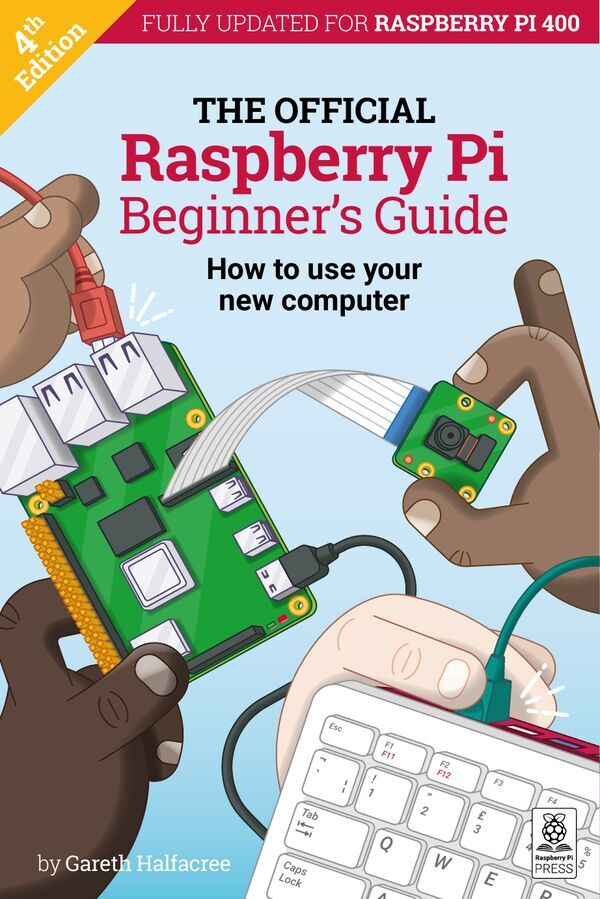
Raspberry Pi Beginner's Guide 4th Edition
"Fully updated for Raspberry Pi 400, Raspberry Pi 4, and the latest software, this 252-page official Raspberry Pi book is crammed with projects and beginner’s guides containing all the information you need to get started using your new computer! Learn how to set up your Raspberry Pi, install an operating system, and start using it. Follow step-by-step guides to code your own animations and games, using both the Scratch 3 and Python languages. Create amazing projects by connecting electronic components to Raspberry Pi’s GPIO pins. Plus much, much more! 252 pages of essential information: Set up your Raspberry Pi, install its operating system, and start using this fully functional computer." [...]
Projetos Maker
Diversos Projetos interessantes.
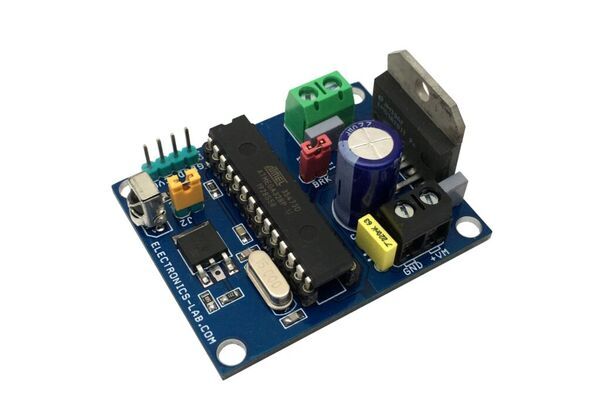
Brushed DC Motor Controller Using Infra-Red Remote
"This project enables the user to control a Brushed DC Motor using an Infra-Red Remote Control, thus controlling speed, direction, and also brake of DC Motor is possible. It’s an Arduino compatible open-source hardware that helps you develop many DC Motor control applications. The user has to write the code as per the application requirement. The project is based on three main parts, Atmega328 microcontroller, LMD18201 DC Motor H-bridge, and TSOP1838 Infra-red receiver. This board can control DC motor up to 48V DC with continuous current up to 3A and with peak current 6A. " [...]

4.2in E-Paper Spotify Weather Clock
"This project uses Python3 to display two users' recent Spotify history, weather for two cities (local and away), and the current time Written for Waveshare's 4.2 e-paper display, this project connects with Spotify's API to display the most recent listening information, including the title, artist, context, and time since the track was played. There is a left and right panel so that two folk's listening can be displayed at the same time. The forcast and current weather are also displayed via the OpenWeatherMap api. The e-paper display updates in full every 3 minutes per Waveshare's recommendations. After 8pm, the display updates every 5 minutes, and does not update from 2am - 6am. Before you ask, I am using the Nintendo DS BIOS font for this project because it looks beautiful." [...]

DIY Android+Arduino Controlled Labyrinth (Maze) Game
"The device presented is marble maze game that is controlled using a smartphone via Bluetooth connection. The device presented above in the video represents marble maze game that is controlled using a smartphone via Bluetooth connection. The device consists of two parts. The first is the Arduino part where the servo motors are controlled and the second part where the signals generated by the accelerometer are sent via the Android smartphone. It consist few components: - Arduino Nano microcontroller - Bluetooth adapter - and two 9g servo motors The application to be installed on the smartphone is: "Sensoduino" from Hazim Bitar, and the.APK file is given below. Tilt and pan signals from the accelerometer are converted into motion by the corresponding servo motors." [...]
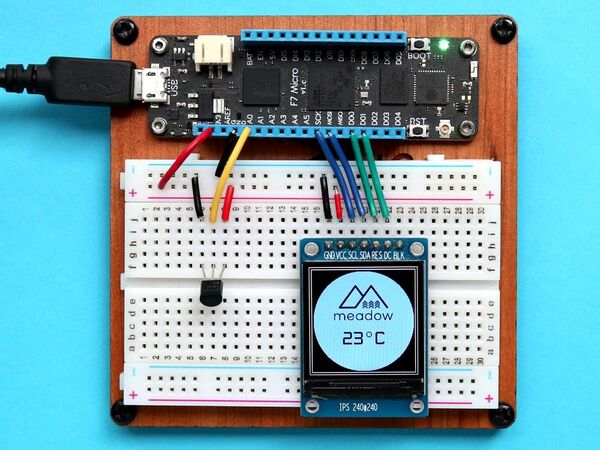
Send Data From Meadow to an ASP. NET Server via Wifi
"Learn how easy is to connect Meadow to a WiFi network and send data to a ASP. NET server using an HttpClient and (de)serialize with Json. In this project we're going to learn how to connect Meadow to a WiFi network and log the room temperature with an LM35 analog temperature sensor sending the data periodically to an ASP.NET server running on a PC. Everything you need to build this project is included in the Wilderness Labs Meadow F7 w/Hack Kit Pro. We'll see how easy is to program these peripherals using Meadow.Foundation. Meadow.Foundationa platform for quickly and easily building connected things using.NET on Meadow." [...]

Arduino Powered Painting Robot
"Have you ever wondered if a robot could make mesmerizing paintings and art? In this project I attempt to make that a reality with an Arduino Powered Painting Robot. The objective is for the robot to be able to make paintings on its own and use a reference image as a guide to replicate an artwork. I used the power of CAD and digital fabrication to create a robust chassis onto which I mounted an arm that could dip the paint brush into one of the 7 paint containers and draw on the canvas. The robot is made using common parts such as stepper motors and servo motors and it is designed to work with any kind of paint. Follow on to create your own Arduino Powered Painting Robot and do drop a vote for this project in the "Paint Challenge" if you enjoyed the project and decide to build your own version." [...]
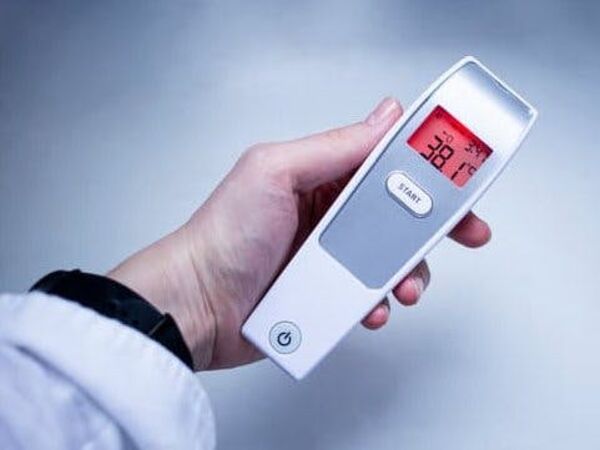
Automatic temperature detecting system
"Automatic temperature detecting system that can be quite helpful to the offices at this time of the pandemic At this time of the pandemic, all the offices are closed because of Coronavirus. This project can be quite helpful to the offices at this time as it can be installed outside the office and will help to sense the temperature of every person who is coming to the office. It has a PIR sensor that will detect the person coming and will start the whole project by showing an alert on the LCD. then the ultrasonic sensor will calculate the distance and then these two pieces of information will be shown on the LCD. That is, if any person is detected by the PIR sensor it will show 'alert ', and it will show the distance measured by the ultrasonic sensor. The distance will be shown in both cm and inches." [...]
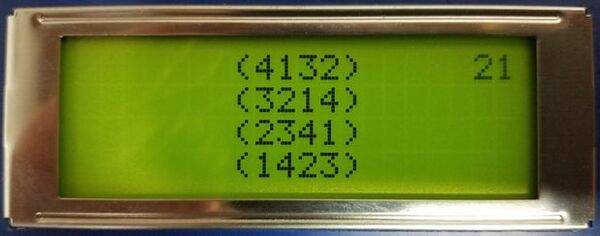
Arduino Sorta Sudoku Game
"A lot of people like to play Sudoku and the grandkids like guessing games so I decided to make a portable Sorta Sudoku game. In my version the game is a 4x4 grid but only one number is provided. The idea is to guess the rest of the numbers in the fewest tries. Its a simple game but it can be kind of addicting as you pursue the perfect score of 15. The game requires both an element of luck as well as logic and the best score Ive seen so far is 16. Take a look because even if you arent interested in building the game, there might be some elements of the software that you can use in one of your own projects." [...]

UART Interface in VHDL for Basys3 Board
"A tutorial on creating an UART interface between the Basys 3 board and the computer terminal in VHDL running on FPGA. Some time ago, I was looking for an UART design in VHDL that was easy to follow, and surprisingly I couldn't find one. Maybe I didn't search well enough, but anyway, I though this would be a good starting point for my tech hobby blog. So, this is my first project, please welcome UART interface in VHDL for the Basys 3 board. This design allows transmitting bits from the board to the computer terminal, and receiving bits from the terminal to the board. You can transmit data from the board to the terminal by pressing the push button on the board." [...]

WiFi Clock
"A WiFi clock who also displays temperature & weather if it turns bad ! This project is a clock and a free formed circuit sculpture. This was heavily inspired by Mohit Bhoites work, Im a huge fan and I wanted to build something like what he makes for myself. The second guideline was using brass and walnut, because I love the color of this wood, and how it contrasts with brass. And the third one was to have fun with a WiFi processor, and tried some other component, which are not very complicated, but I had never had the opportunity to play with them. " [...]
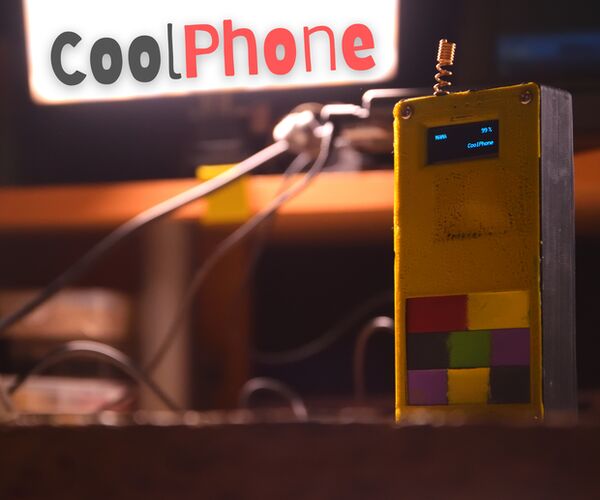
DIY Phone - CoolPhone!
"I recently developed a prototype of my own Arduino based phone. Time to improve it. In the previous video, I built a phone on a breadboard that I called CoolPhone. I had no major problems with the prototype, I just had to eliminate noises on the microphone and speaker. So it might seem that the rest of the project will go smoothly, and it should be, but it turned out a bit differently. After all, CoolPhone works, but let me tell you now that I have plans to make it better." [...]
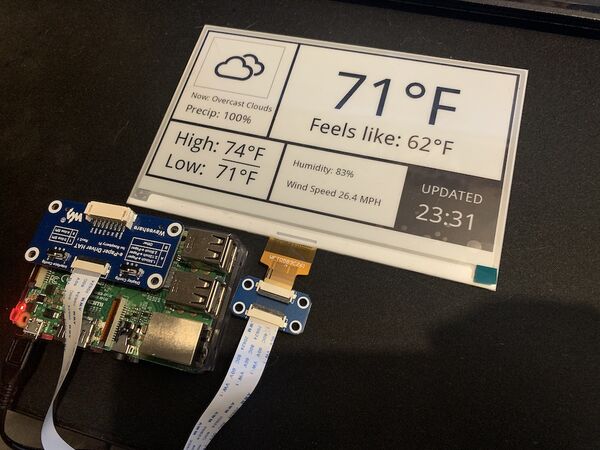
E-paper Weather Display
"Raspberry Pi weather display using Waveshare e-paper 7.5 inch display, Open Weather Map API, and Python. " [...]

Useless Box With an Attitude
"Who really wants a useless box? Nobody. I thought so at first, but there are thousands of useless boxes on YouTube.. So they must be trendy.. In this instructable I will show you how to make a slightly different useless box, one with lights, sound and a real attitude. The box is ticking with the help of an Arduino UNO R3 board, assisted by two ISD1820 sound boards." [...]
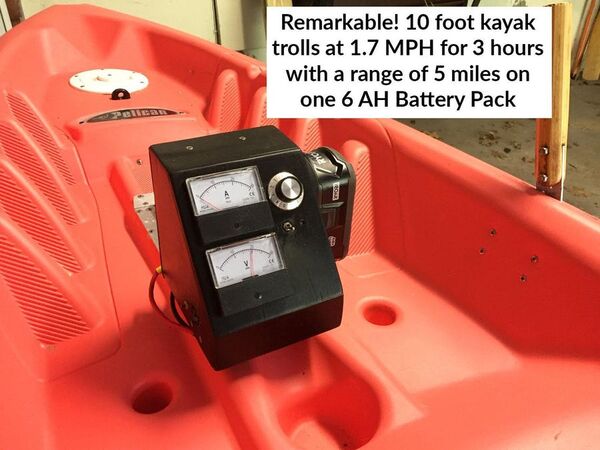
An Electric Kayak
"Project uses an Arduino Uno computer and an 18 volt battery pack to efficiently power a 10 foot kayak electrically. Project Overview The photo above shows the console used to propel a 10 foot kayak electrically. The console contains an Arduino Uno computer capable of generating Pulse Width Modulation (PMW) signals. The Cytron driver, a 2 by 3 inch circuit board located next to the Uno, interprets the PWM signals and powers the trolling motor as it would a robot motor. On the side of the console, a stock 4 Ampere Hour (AH) or 6 AH Ryobi Lithium battery pack (used to power cordless tools) provides the operating power for the trolling motor. The console also provides a voltmeter and an ammeter to monitor the battery charge and the power flowing to the motor." [...]
Schwurbler - A DIY Lightroom Midi Controller
"The community of the HappyShooting Podcast shares an opensource hardware midi controller for Adobe Lightroom. From and for photographers. The german #1 photo-podcast Happy Shooting made by Boris Nienke and Chris Marquardt had a discussion about Midi controller for Lightroom. One comment on the website, why not building it yourself and voila the project was born. The name Schwurbler is the german colloquial for a Conspiracy theorists. This project contains everything from zero to hero and to create your very own customized Midi Controller for Lightroom Classic." [...]

Nerf Light Gun Controller
"Ever since building my Nerf Vulcan Sentry Gun, I wanted to modify a Nerf blaster that allows me to control a computer and play games. It took me a long time to get started, but I can finally show you the results. Ever since I have finished modifying the blasters, I can't put them down. Playing them is insanely fun and I hope you enjoy the mod as much as I do. The blaster can not only be used to control a PC but also to play games with for example a RetroPie or MAME. " [...]
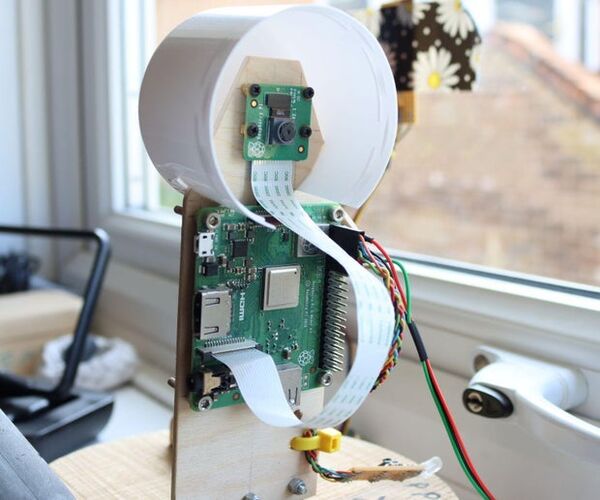
Raspberry PI Time Lapse (bean Growing)
"A little project whilst in Corona virus lockdown to keep the kids occupied. The push button is something i have used for a while and the information on how it works can be found in my Raspberry_Pi_Input_Output_Trocopter instructable. For this project i have added a light sensor so the picture is only taken in day light hours. There are a few ways i could have done this part of the project, for example i could have made up an op amp circuit, with the op amp in a comparator mode and a variable resistor to set the light level. But i don't have a lot of electronic components, so it was a lot easier to go down the Arduino nano route. Raspberry pi Raspberry pi camera substantial stand and a means of clamping it into place." [...]
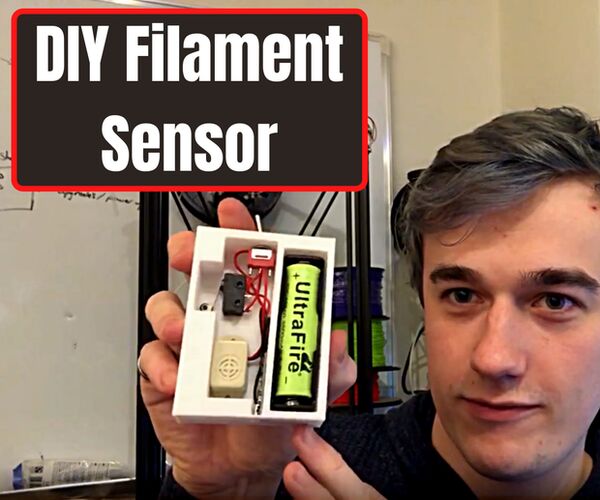
DIY Filament Sensor
"Hey! This was a weekend project of mine. While stuck in Covid lockdown in the U.K. there's nothing much to do except create and make things. Using some spare parts which any hobbist will have I was able to create a sensor which warns me when I'm low on filament for my 3D printer. As any 3D printerist will know, running out of filament mid print is one of the most painful experiences to have to watch. (Ok maybe I exaggerate a bit)." [...]
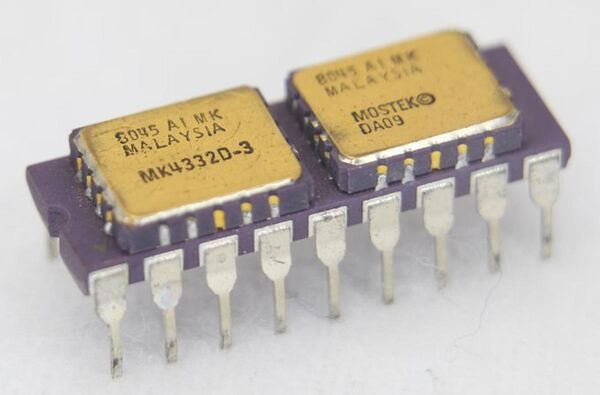
Inside the stacked RAM modules used in the Apple III
"In 1978, a memory chip stored just 16 kilobits of data. To make a 32-kilobit memory chip, Mostek came up with the idea of putting two 16K chips onto a carrier the size of a standard integrated circuit, creating the first memory module, the MK4332 "RAM-pak". This module allowed computer manufacturers to double the density of their memory systems and by 1982, Mostek had sold over 3 million modules. The Apple III is the best-known system that used these memory modules. This module was built from two 16-kilobit memory chips, constructed from the standard MK4116 dynamic RAM (DRAM) chip packaged in a leadless ceramic chip carrier; these are the golden rectangles on top of the carrier. You might wonder why customers didn't simply use these surface-mount packages directly, but at the time soldering surface-mount components was still a challenge for many customers." [...]
DIY solar tracker
"This system can track the sun all day long, can be used for harvesting 15% more energy than typical static Solar Plates. When we use typical static solar plates, a great amount of solar energy is wasted because of the angle of the sun. Using this system we can move the solar plates according to the sun, harvesting more and more solar energy. " [...]
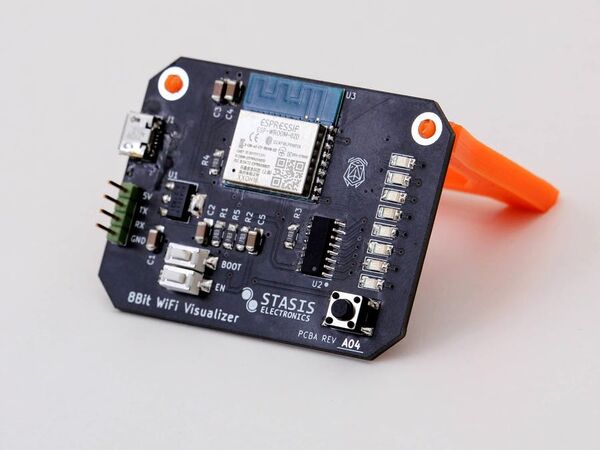
Network Traffic Visualizer
"Open source custom circuit board that uses an ESP8266 to capture packets on the current WiFi channel, and display the intensity on 8 LEDs. At its core, this board design is a simple desk toy that connects an ESP8266 module to a shift register to display data on the 8 blue LEDs.To make things a little bit more interesting, I've written an Arduino sketch that measures how many packets are flying around on the ESP's WiFi channel, and displaying the intensity on the LEDs much like a VU meter. " [...]
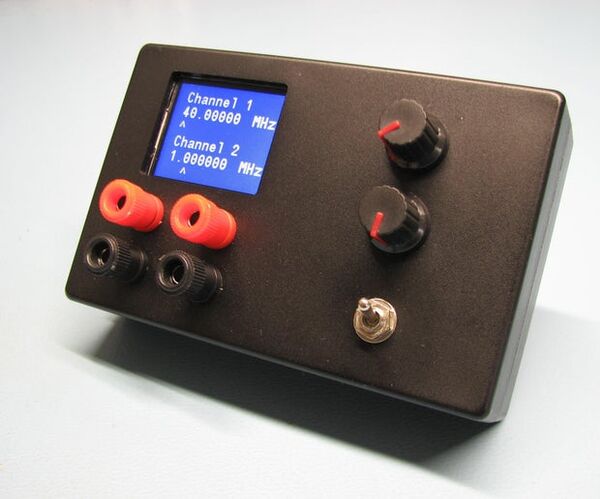
Clock Generator With Si5351 and Blue Pill
"Clock generator I recently build a pulse generator and it does its job well. It produces pulses of variable length and at several frequencies. But the number of frequencies it can produce is limited and for many jobs the length of a pulse is less important than its frequency. E.g. when you are testing a clock you need a certain frequency, often 32768 Hz, but the pulsewidth (duty cycle) isn't so important. To address this I made a clock generator, it produces squarewaves of (approx) 50% duty cycle for every frequency." [...]
The Neopixel LED Vase
"This vase uses transparent 3D printer filament as a light guide. The filament is integrated in a vase to realize light effects with addressable Neopixel LEDs. Therefore a LED ring is inserted in the base of the vase and controlled by an Arduino board. The transparent filament guides the LED light through channels in the vase structure to the top of the vase. This project was partly inspired by the 3D filament vase from 3DWinnipeg. Supplies: Adafruit NeopixelRing 16 Adafruit Trinket M0 2.85mm transparent PETG filament some wires" [...]

Universal Tensile Testing Machine VERSION TWO
"I have made a promise to publish the new version in fall in the original version. Well, here it is, the now "Universal" Tensile Testing Machine Version 2! I might publish it on Thingiverse as well (though I'm not certain). Background Info I am a 9th grade student at Arizona College Prep Erie Campus. The project to make a tensile testing machine started all the way back in 8th grade when my friend and I wanted to make science fair projects on the tensile strengths of 3D printed testing specimens. We successfully designed a fully functional tensile testing machine in Tinkercad and used it for our Science Fair projects." [...]
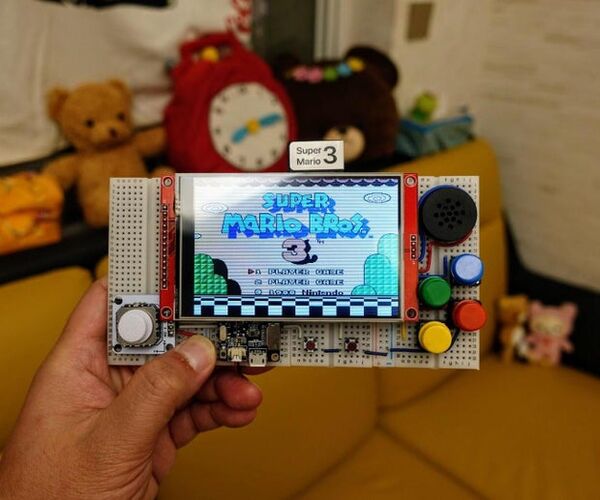
Arduino NES
"This instructables show how to build a portable NES console with Arduino IDE. Note: currently most NES emulator required manual command line build with sort of C compiler, e.g. esp-idf, it is a big barrier for the beginner. I believe make it Arduino IDE compatible can break this barrier, enjoy! Supplies:4.0 inches ST7796S SPI LCD module FOUR NUMBER OF 400 holes breadboard TTGO T8 v1.7 ESP32 Dev Board MAX98357 I2S Amplifier module PCB Mount Mini Speaker PSP Analog joystick module SIX NUMBER OF button key module" [...]

Face Recognition On NVIDIA JETSON NANO
"This is a device that can recognize faces and then send the results via serial communication A few months ago I bought a NVIDIA JETSON NANO DEVELOPER KIT and then I searched the internet what I could do with this thing. I was so surprised with what I got, it turns out this thing can do many things as shown on its website https://developer.nvidia.com/ then I started to make a project using this with the tutorial contained here https://developer.nvidia.com/embedded/learn/get-started-jetson-nano-devkit#intro then I learned some material from the NVIDIA DEEP LEARNING INSTITUTE like hello world AI and others https://developer.nvidia.com/embedded/learn/jetson-ai-certification-programs#course_outline Armed with a sample program and several libraries, finally I made face recognition with this board. you can see it here for the library https://github.com/ageitgey/face_recognition" [...]

Bluetooth Car with Auto Breaking & Speed Controller
"The project includes how to design and develop a Bluetooth Controlled Robot with Speed Control and Auto Breaking System. Bluetooth Controlled Car Robot with Speed Control and Auto Breaking System using L293D Motor Driver Shield This project includes how to design and develop a Bluetooth Controlled Robot with Speed Control and Auto Breaking System using L293D Motor Driver Shield. Components Required Arduino UNO Rev 3 L293D Motor Driver Shield HC-05 Bluetooth Module HC-SR04 Ultrasonic Sensor 2WD Robot Chassis Kit with Gear Motors 18650 Battery Holder 2 x 18650 Batteries Connecting Wires / Jumper Wires / Male& Female Connectors/ Heat Sleeves Vero Board Soldering Iron / Solder / SolderingPaste Android Phone Bluetooth Controller App" [...]
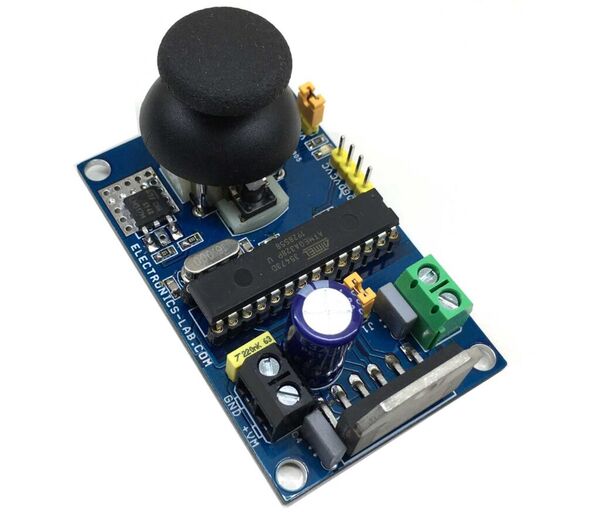
Brushed DC Motor Speed and Direction Controller Using Joystick
"This DC Motor controller provides direction and speed control of a brushed DC motor using a Joystick. This is an Arduino compatible open-source hardware with various applications. It can be used to control scissor lift motor, Linear actuator, Camera slider, camera pan-tilt head, curtain motor, power window motor, robotics, smart furniture automation, hospital furniture automation, projector up/down controller, TV up/down controller are few application examples. The board provides superb performance, smooth movement of motor, and hassle-free use. You only need to connect the motor wires, power the board, and you ready to go. The controller has 3 main elements, Atmega328 Micro-Controller, LMD18201 DC Motor H-bridge, and Joystick connected to A0 Analog pin of microcontroller." [...]

Wireless solar-powered sensor node
"A solar-powered node that stores energy in a supercapacitor, wakes-up regularly, measures different parameters, and sends them to a gateway The main idea is to create a relatively small device that measures temperature and humidity (or anything else using a low-power i2c sensor), sends data to a gateway, and never requires a battery change. In the current iteration, I going to use an ATmega328P microcontroller, RFM69W transceiver, 1-1.5F supercapacitor, and some additional components to provide over/under voltage protection. " [...]
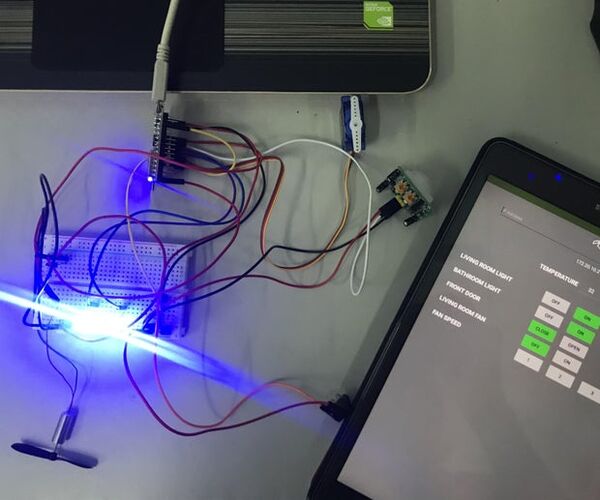
NodeMCU ESP8266: Home Automation System With Sensors and MIT App Inventor 2
"Hey guys, this is a project me and my friends make for our Final Year Project. We have gone through a lot of research from a lot of websites including this one to make this project worked as it should. So what I am trying to do is to give you guys my 2 cents of knowledge to you guys/students/girls/teacher/lecturer/robots or whatever you are. So, in this "Instructable" I will share, how to create a useable and reliable Home Automation System or Smart Home for you to recreate at your own comfort. Also, I will share how to create your own simple web server for your NodeMCU ESP8266 and how to create your own MIT APP Inventor. Well, I will be putting links below." [...]
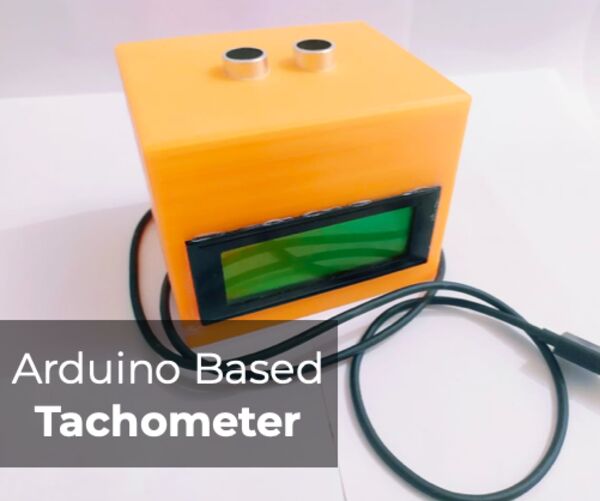
Arduino Based Tachometer for Gym Cycles
"My grandfather tries to exercise regularly on the gym cycle he has, however, the display for the cycle is broken. Therefore he is unable to see the distance travelled by him after exercising for a certain period of time. The LCD used on the gym cycle to display the data was custom made and could not be replicated. He was unwilling to exercise without an indication of the distance travelled. Therefore, I came up with this solution where my grandfather could still measure the number of cycle revolutions over a certain period of time and calculate the distance travelled. This project won't apply for regular cycles, but for exercise bikes, it is a perfect option if the LCD display is old or damaged." [...]

Home Automation Using Arduino and WiFi Module ESP01 | Arduino ESP8266 Control Relay
"In this IoT project, I have shown how to make IoT based Home Automation using Arduino and WiFi module ESP01 to control relays from the manual switch, smartphone, IR remote. This smart relay also can sense the room temperature and sunlight to turn on and off the fan and light bulb automatically. This smart relay has the following features: This Smart Home System has the following features:1. Home appliances control from WiFi (Blynk App) 2. Home appliances controlled with manual switches. 3." [...]

ATTiny85 Capacitor Meter
"This instructable is for a Capacitor meter based on the ATTiny85 with the following features. Based on ATTiny85 (DigiStamp) SSD1306 0.96" OLED Display Frequency measurement for low value capacitors 1pF - 1uF using 555 oscillator Charge time measurement for high value capacitors 1uF - 50000uF 2 separate ports used for the methods to minimise stary capacitance Two values of current used for Charge Time to minimise time for large capacitors 555 method self zeros at start up, can be rezeroed with push button A quick test used to select which method should be used for each cycle of measurement. Charge time method accuracy can be improved by support for OSCVAL clock frequency adjustment" [...]

DIY - IR Module
"A sensor is a device that detects and responds to inputs from the physical environment. The input can be light, heat, motion, moisture, pressure, or any other environmental phenomena. Sensors are very important part of electronics, especially in Robotics and Automations. The output generated by the sensors are transmitted to other circuits for reading or for further processing. They make our life easy by automatically sensing and controlling devices, without human interaction. In this tutorial, we are going to talk about "IR sensors" or Infrared sensors, how they work and how to build a "DIY IR Sensor Module"." [...]
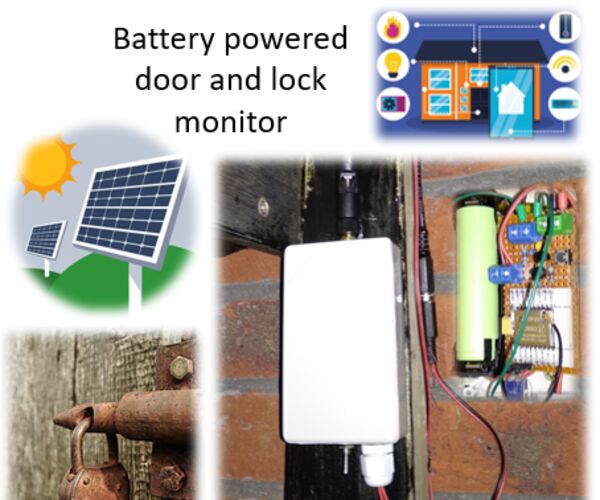
Battery Powered Shed Door & Lock Sensor, Solar, ESP8266, ESP-Now, MQTT
"In this Instructable I show you how I made a battery powered sensor to monitor the door and lock status of my remote bike shed. I have nog mains power, therefor I have it battery powered. The battery is charged by a small solar panel. The module is designed for low power operation and runs on an ESP-07S in deep sleep which wakes up and checks the door and lock position every minute. However, when the door is opened, the module is woken by a simple hardware circuit to immediately send the 'door open' information. The module communicates via ESP-Now, in which the transmission time is very short, requiring only a small amount of energy." [...]

Portable Sound Analyzer on ESP32
"Sounds are everywhere and always around us. Whether it is your name spoken by your beloved, a barking dog, music played on television or the horn of a car... Our brain processes sounds through its ability to transform the sound waves picked up by our ears. But wouldn't it be fun to really be able to visualize these waves and try to understand them as well? That's what I tried to do with this project. A microphone captures the waves, transforms them into electrical signals that can be processed by a microcontroller and displayed on a screen. Of course, it has to be fun, fast, informative and portable." [...]
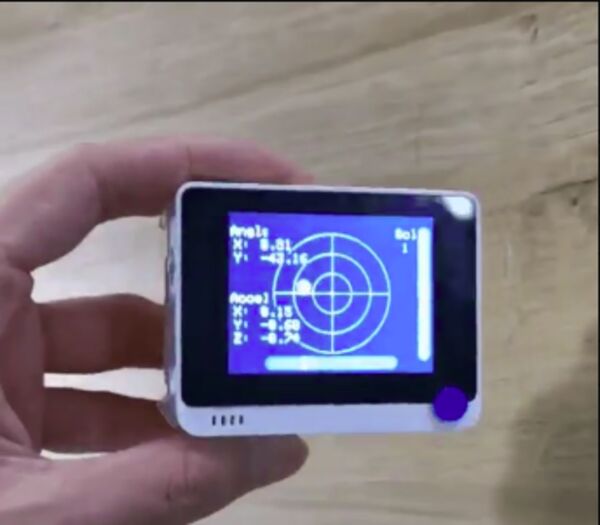
Wio terminal level
"All-purpose Wio terminal also can as a level for establishing a horizontal plane. The powerful Wio terminal is really convenient to use and multipurpose, last time I made an attitude indicator via used the build-in gyroscope, and this time I used it to make a level for establishing a horizontal plane, it also has high accuracy measure function, and I don't need to carry a long and heavy level to work anymore. " [...]
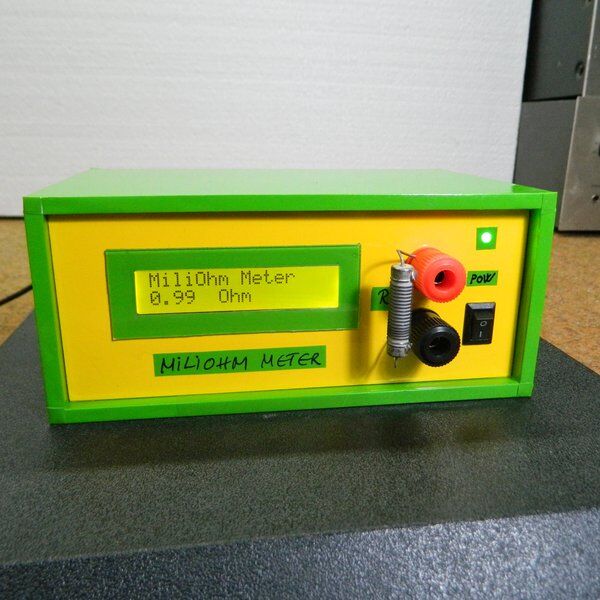
DIY Arduino Miliohmmeter for measure low value res
"Measuring low resistances with a standard multimeter is difficult and very inaccurate. This device solves this problem and serves for accurate measurement of small resistances in the range of 0.1 ohm up to 50 ohms. This device is very simple and easy to make and contains the following components: - Arduino Nano microcontroller - 16x2 LCD display - LM317 voltage regulator - Potentiometer - and resistor 12 Ohm" [...]
That's all Folks!



